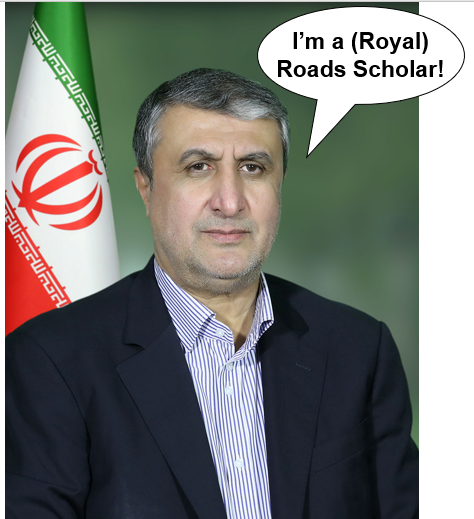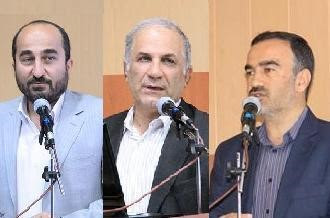Mohammad Eslami, head of the AEOI - who is he really?
Iran's president Ebrahim Raisi spent much of his first few months in office since August last year sweeping out the remnants of any former government ministers who might have a whiff of reformism or internationalism about them. One victim of this clean-out has been the urbane Ali Akbar Salehi (علی اکبر صالحی), who headed the Atomic Energy Organization of Iran (AEOI or سازمان انرژی اتمی ایران) from 2009 to 2010 and then again from 2013, and was for all intents and purposes the public face of Iran's nuclear program. Salehi made a famous double-act with US Secretary of Energy Ernest Moniz, teaming up in the JCPOA talks to wrestle together a highly complex and technical negotiated agreement.
With Raisi at the helm, negotiations with the enemy are no longer in vogue, and Salehi is out. And Salehi's replacement is someone who has what we in the Iran nuclear fanboy/fangirl community would call "form" - that distinctive characteristic of having been so deeply involved in Iran's historic nuclear weapon-related activities that they can never really escape.
Although to be honest, we're not sure that Engineer Mohammad Eslami (مهندس محمد اسلامی), the new head of the AEOI, has has ever really wanted to escape. Eslami has the kind of resume that marks him as a true insider of Iran's military-industrial complex - as well as one who knows where all sorts of skeletons are buried when it comes to the nuclear program, past and present.
Let's take a quick look at Engineer Eslami's most attractive qualities, at least from the perspective of the new government - which should make very clear why he was picked to take over the AEOI.
1. He knows the background - going way, way back.
Eslami has been employed at high levels in Iran's defence sector since the mid-1980s, including in roles which would by definition require involvement in those covert aspects of Iran's nuclear program that have traditionally been run by the military or Islamic Revolutionary Guards Corps or IRGC.
According to Eslami's official resume, from 1987 until 1995 he served as Deputy of Engineering and Development Plans of the Defense Industries Organization (DIO or سازمان صنایع دفاعی), the main manufacturing hub of Iran's military industries. The DIO, as the IAEA has previously made clear, was also a manufacturer and tester of components and equipment for Iran's secret centrifuge program - and probably had aspirations to build centrifuges of its own before the AEOI proved to be the more competent centrifuge operator.
And Eslami was at the heart of DIO's interactions with the then-secret centrifuge program. The often wrong but sometimes right opposition group NCRI has claimed that during his tenure at DIO, Eslami was actually one of the Iranian officials who struck Iran's first deal with the notorious Pakistani proliferator AQ Khan, who provided Iran with a stash of centrifuge drawings and components to kickstart their uranium enrichment program. We haven't seen the evidence to corroborate the NCRI's allegation, but it is entirely consistent with the official role that Eslami says he had in 1987 - when, as has been widely reported, three Iranian officials met with Khan's associates in Dubai to hash out a secret deal.
After 1995, as Eslami's CV shows, Eslami had a string of jobs which would have involved engagement with Iran's pre-2003 nuclear weapons program; the post-2003 clean-up effort; and activities after 2003 which were designed to keep relevant expertise and incrementally edge forward Iran's capabilities without triggering a response by their adversaries. These roles included leading the Defence Industries Research and Training Institute (DIRTI aka TRIDI aka DITRI aka MAVT aka ERI, or مؤسسه آموزشي و تحقيقاتي صنايع دفاعي) from at least 2004 until 2007. DIRTI, as the IAEA has authoritatively reported in the past, oversaw the nuclear R&D activities of Mohsen Fakhrizadeh and his team from the outset of the pre-2003 nuclear weapons program (the notorious "Amad Plan") until at least 2009.
Sorry for the history lesson. But why this all matters right now is because the IAEA is obssessively focused on determining what happened in the early days of Iran's nuclear program - specifically, what exactly happened to the nuclear material which the IAEA has detected at several locations associated with the Amad Plan and related clean-up efforts. Eslami knows the answer - and, we posit, Iran's leadership has judged that he knows best how to hide the answer from the IAEA. We'll see who wins out.
2. Eslami's appointment is a middle finger to Iran's enemies.
Those of us old enough to remember life before Tik Tok will recall that Iran has previously made a controversial appointment as head of the AEOI: in 2011, when former president Mahmoud Ahmadinejad shocked Iran-watchers by naming Fereidoun Abbasi-Davani (فﺮﻳﺪﻭﻥ ﻋﺒﺎﺳﻰ ﺩﺍﻧﻴﻪ, national ID 1818879433) to the post. Abbasi-Davani's hiring was a big up-yours to those who had tried to assassinate him a few months earlier, with that failed attempt on Abbasi-Davani's life doubtless spurred by his role as one of the key physicists of the Amad program. We think that Eslami's hiring is in a similar vein - it is meant to signal that not only Iran is not going to come clean about past activities, it will treat efforts to understand them with contempt.
3. Eslami has really great academic credentials.
We jest, and yearn for the days when we had an MIT grad (Dr Salehi) as head of the AEOI. Mohammad Eslami has no better credentials than any other Iranian politician who benefited from a pre-1979 bachelor's education from an American university, before going on to take a postgrad degree at a second-tier university, and ultimately joining the gravy train of public service. We apologize to our loyal readers who studied at Canada's Royal Roads University, where Eslami reportedly took his masters degree; but forgive us for our judgment that the most notable feature of Royal Roads is that it doubled as Professor Xavier's School for Gifted Youngsters in the X-Men films.
Forget Eslami's subsequent roles as Minister for Roads (seriously) and Governor of Mazandaran Province; these are rewards posts for a regime crony rather than marking any particular talent.
Overall, we don't hold high hopes for much actual success in the AEOI while Eslami is at the helm. He'll be much too busy stuffing skeletons back in the cupboard.










Comments
Post a Comment